Piezoelectric Ceramic/Photopolymer Composites Curable with UV Light: Viscosity, Curing Depth, and Dielectric Properties
Abstract
:1. Introduction
State-of-the-Art
2. Materials and Methods
| Property | BTO | KNN7 | KNN3.5 | PZT |
|---|---|---|---|---|
| Particle size from SEM, μm (size deviation in %) | 0.122 ± 0.023 (18.8%) | 0.326 ± 0.130 (39.8%) | 0.629 ± 0.227 (36%) | 1.258 ± 0.659 (52.4%) |
| Particle geometry | Spherical | Random | Cubic | Random |
| Theoretical density, g/cm3 | 6.02 | 4.4 | 4.4 | 7.8 |
| Refractive index 1 | 2.37–2.64 2 | 2.3–2.54 3 | 2.3–2.4 3 | 2.5–2.85 4 |
| Lattice structure 5 | Cubic (non-piezoelectric) | Orthorhombic—tetragonal | orthorhombic | tetragonal |
2.1. Suspension Preparation
2.2. Piezoelectric Composite Sensor Manufacturing
2.3. Characterization Methods
3. Results and Discussion (Ceramic and Solvent Investigation)
3.1. X-ray Diffraction of Ceramic Particles
3.2. Solvent Influence on Composite Properties
3.3. Piezoelectric Ceramic Influence on Composite Properties
4. Conclusions
Supplementary Materials
Author Contributions
Funding
Institutional Review Board Statement
Informed Consent Statement
Data Availability Statement
Acknowledgments
Conflicts of Interest
References
- Akdogan, E.K.; Allahverdi, M.; Safari, A. Piezoelectric composites for sensor and actuator applications. IEEE Trans. Ultrason. Ferroelectr. Freq. Control 2005, 52, 746–775. [Google Scholar] [CrossRef] [PubMed]
- Bodkhe, S.; Ermanni, P. Challenges in 3D printing of piezoelectric materials. Multifunct. Mater. 2019, 2, 22001. [Google Scholar] [CrossRef]
- Chen, Z.; Li, Z.; Li, J.; Liu, C.; Lao, C.; Fu, Y.; Liu, C.; Li, Y.; Wang, P.; He, Y. 3D printing of ceramics: A review. J. Eur. Ceram. Soc. 2019, 39, 661–687. [Google Scholar] [CrossRef]
- Halloran, J.W. Ceramic Stereolithography: Additive Manufacturing for Ceramics by Photopolymerization. Annu. Rev. Mater. Sci. 2016, 46, 19–40. [Google Scholar] [CrossRef]
- Cha, J.; Lee, J.W.; Bae, B.; Lee, S.-E.; Yoon, C.-B. Fabrication and Characterization of PZT Suspensions for Stereolithography based on 3D Printing. J. Korean Ceram. Soc. 2019, 56, 360–364. [Google Scholar] [CrossRef] [Green Version]
- Zeng, Y.; Jiang, L.; Sun, Y.; Yang, Y.; Quan, Y.; Wei, S.; Lu, G.; Li, R.; Rong, J.; Chen, Y.; et al. 3D-Printing Piezoelectric Composite with Honeycomb Structure for Ultrasonic Devices. Micromachines 2020, 11, 713. [Google Scholar] [CrossRef]
- Dufaud, O.; Corbel, S. Stereolithography of PZT ceramic suspensions. Rapid Prototyp. J. 2002, 8, 83–90. [Google Scholar] [CrossRef]
- Singh, P.; Smith, L.S.; Bezdecny, M.; Cheverton, M.; Brewer, J.A.; Venkataramani, V. Additive manufacturing of PZT-5H piezoceramic for ultrasound transducers. In Proceedings of the 2011 IEEE International Ultrasonics Symposium (IUS), Orlando, FL, USA, 18–21 October 2011; IEEE: Piscataway, NJ, USA, 2011; pp. 1111–1114. [Google Scholar] [CrossRef]
- Chabok, H.; Zhou, C.; Chen, Y.; Eskandarinazhad, A.; Zhou, Q.; Shung, K. Ultrasound Transducer Array Fabrication Based on Additive Manufacturing of Piezocomposites. In Proceedings of the ASME/ISCIE 2012 International Symposium on Flexible Automation, St. Louis, MO, USA, 18–20 June 2012; pp. 433–444. [Google Scholar] [CrossRef]
- Woodward, D.I.; Purssell, C.P.; Billson, D.R.; Hutchins, D.A.; Leigh, S.J. Additively-manufactured piezoelectric devices. Phys. Status Solidi A 2015, 212, 2107–2113. [Google Scholar] [CrossRef] [Green Version]
- Chen, Z.; Song, X.; Lei, L.; Chen, X.; Fei, C.; Chiu, C.T.; Qian, X.; Ma, T.; Yang, Y.; Shung, K.; et al. 3D printing of piezoelectric element for energy focusing and ultrasonic sensing. Nano Energy 2016, 27, 78–86. [Google Scholar] [CrossRef] [Green Version]
- Song, X.; Chen, Z.; Lei, L.; Shung, K.; Zhou, Q.; Chen, Y. Piezoelectric component fabrication using projection-based stereolithography of barium titanate ceramic suspensions. Rapid Prototyp. J. 2017, 23, 44–53. [Google Scholar] [CrossRef]
- Komissarenko, D.A.; Sokolov, P.S.; Evstigneeva, A.D.; Shmeleva, I.A.; Dosovitsky, A.E. Rheological and Curing Behavior of Acrylate-Based Suspensions for the DLP 3D Printing of Complex Zirconia Parts. Materials 2018, 11, 2350. [Google Scholar] [CrossRef] [PubMed] [Green Version]
- Santawitee, O.; Grall, S.; Chayasombat, B.; Thanachayanont, C.; Hochart, X.; Bernard, J.; Debéda, H. Processing of printed piezoelectric microdisks: Effect of PZT particle sizes and electrodes on electromechanical properties. J. Electroceramics 2019, 188, 383. [Google Scholar] [CrossRef]
- Cheng, J.; Chen, Y.; Wu, J.-W.; Ji, X.-R.; Wu, S.-H. 3D Printing of BaTiO3 Piezoelectric Ceramics for a Focused Ultrasonic Array. Sensors 2019, 19, 4078. [Google Scholar] [CrossRef] [PubMed] [Green Version]
- Chen, W.; Wang, F.; Yan, K.; Zhang, Y.; Wu, D. Micro-stereolithography of KNN-based lead-free piezoceramics. Ceram. Int. 2019, 45, 4880–4885. [Google Scholar] [CrossRef]
- Kim, K.; Zhu, W.; Qu, X.; Aaronson, C.; McCall, W.R.; Chen, S.; Sirbuly, D.J. 3D Optical Printing of Piezoelectric Nanoparticle–Polymer Composite Materials. ACS Nano 2014, 8, 9799–9806. [Google Scholar] [CrossRef]
- Kim, K.; Middlebrook, J.L.; Chen, J.E.; Zhu, W.; Chen, S.; Sirbuly, D.J. Tunable Surface and Matrix Chemistries in Optically Printed (0–3) Piezoelectric Nanocomposites. ACS Appl. Mater. Interfaces 2016, 8, 33394–33398. [Google Scholar] [CrossRef]
- Yao, D.; Cui, H.; Hensleigh, R.; Smith, P.; Alford, S.; Bernero, D.; Bush, S.; Mann, K.; Wu, H.F.; Chin-Nieh, M.; et al. Achieving the Upper Bound of Piezoelectric Response in Tunable, Wearable 3D Printed Nanocomposites. Adv. Funct. Mater. 2019, 29, 1903866. [Google Scholar] [CrossRef]
- Tiller, B.; Reid, A.; Zhu, B.; Guerreiro, J.; Domingo-Roca, R.; Jackson, J.C.; Windmill, J. Piezoelectric microphone via a digital light processing 3D printing process. Mater. Des. 2019, 165, 107593. [Google Scholar] [CrossRef]
- Yang, Y.; Chen, Z.; Song, X.; Zhu, B.; Hsiai, T.; Wu, P.-I.; Xiong, R.; Shi, J.; Chen, Y.; Zhou, Q.; et al. Three dimensional printing of high dielectric capacitor using projection based stereolithography method. Nano Energy 2016, 22, 414–421. [Google Scholar] [CrossRef] [Green Version]
- Popielarz, R.; Chiang, C.K.; Nozaki, R.; Obrzut, J. Dielectric Properties of Polymer/Ferroelectric Ceramic Composites from 100 Hz to 10 GHz. Macromolecules 2001, 34, 5910–5915. [Google Scholar] [CrossRef]
- Jang, J.H.; Wang, S.; Pilgrim, S.M.; Schulze, W.A. Preparation and Characterization of Barium Titanate Suspensions for Stereolithography. J. Am. Ceram. Soc. 2000, 83, 1804–1806. [Google Scholar] [CrossRef]
- Mitkus, R.; Alashkar, A.T.; Sinapius, M. An Attempt to Topology Optimize 3D Printed Piezoelectric Composite Sensors for Highest D31 Output. In Proceedings of the ASME 2021 Conference on Smart Materials, Adaptive Structures and Intelligent Systems, Virtual, Online, 14–15 September 2021. [Google Scholar] [CrossRef]
- Cui, H.; Hensleigh, R.; Yao, D.; Maurya, D.; Kumar, P.; Kang, M.G.; Priya, S.; Zheng, X. Three-dimensional printing of piezoelectric materials with designed anisotropy and directional response. Nat. Mater. 2019, 18, 234–241. [Google Scholar] [CrossRef] [PubMed]
- Roloff, T.; Mitkus, R.; Lion, J.N.; Sinapius, M. (Eds.) 3D Printable Piezoelectric Composite Sensors for Guided Ultrasonic Wave Detection; MDPI: Basel, Switzerland, 2021. [Google Scholar] [CrossRef]
- Petrossian, G.; Aliheidari, N.; Ameli, A. Thermoplastic Polyurethane/Lead Zirconate Titanate/Carbon Nanotube Composites with Very High Dielectric Permittivity and Low Dielectric Loss. J. Compos. Sci. 2020, 4, 137. [Google Scholar] [CrossRef]
- Tang, J.; Liu, J.; Huang, H. Dielectric, Piezoelectric and Ferroelectric Properties of Flexible 0–3 Type PZT/PVDF Composites Doped with Graphene. J. Electron. Mater. 2019, 48, 4033–4039. [Google Scholar] [CrossRef]
- Gowdhaman, P.; Annamalai, V.; Thakur, O.P. Piezo, ferro and dielectric properties of ceramic-polymer composites of 0–3 connectivity. Ferroelectrics 2016, 493, 120–129. [Google Scholar] [CrossRef]
- Gowdhaman, P.; Antonyraj, K.; Annamalai, V. An effective approach on physical and dielectric properties of PZT-PVDF composites. Int. J. Adv. Sci. Res. 2015, 1, 322–328. [Google Scholar]
- Banerjee, S.; Cook-Chennault, K.A.; Du, W.; Sundar, U.; Halim, H.; Tang, A. Piezoelectric and dielectric characterization of corona and contact poled PZT-epoxy-MWCNT bulk composites. Smart Mater. Struct. 2016, 25, 115018. [Google Scholar] [CrossRef]
- Babu, I.; de With, G. Enhanced electromechanical properties of piezoelectric thin flexible films. Compos. Sci. Technol. 2014, 104, 74–80. [Google Scholar] [CrossRef]
- Babu, I.; de With, G. Highly flexible piezoelectric 0–3 PZT–PDMS composites with high filler content. Compos. Sci. Technol. 2014, 91, 91–97. [Google Scholar] [CrossRef]
- Sharma, S.K.; Gaur, H.; Kulkarni, M.; Patil, G.; Bhattacharya, B.; Sharma, A. PZT–PDMS composite for active damping of vibrations. Compos. Sci. Technol. 2013, 77, 42–51. [Google Scholar] [CrossRef]
- Narita, F.; Wang, Z.; Abe, S. On the Energy Harvesting Potential of Lead- Free Piezoelectric Composites from Air-Flow and Temperature Change. Res. Dev. Mater. Sci. 2018, 5, 000607. [Google Scholar] [CrossRef]
- Ferreira, O.B.; Venkat, R.S.; Adam, J.; Boller, C. Development of the Fabrication Process and Characterization of Piezoelectric BaTiO3/Epoxy Composite Used for Coated Ultrasonic Transducer Patterns in Structural Health Monitoring. In Proceedings of the 19th World Conference on Non-Destructive Testing, Munich, Germany, 13–17 June 2016. [Google Scholar]
- Chao, F.; Liang, G.; Kong, W.; Zhang, Z.; Wang, J. Dielectric properties of polymer/ceramic composites based on thermosetting polymers. Polym. Bull. 2008, 60, 129–136. [Google Scholar] [CrossRef]
- Patsidis, A.C.; Kalaitzidou, K.; Psarras, G.C. Carbon or Barium Titanate Reinforced Epoxy Resin Nanocomposites: Dielectric, Thermomechanical and Functional Behaviour. J. Adv. Phys. 2013, 2, 7–12. [Google Scholar] [CrossRef]
- Dang, Z.-M.; Yu, Y.-F.; Xu, H.-P.; Bai, J. Study on microstructure and dielectric property of the BaTiO3/epoxy resin composites. Compos. Sci. Technol. 2008, 68, 171–177. [Google Scholar] [CrossRef]
- Jeong, C.K.; Park, K.-I.; Ryu, J.; Hwang, G.-T.; Lee, K.J. Large-Area and Flexible Lead-Free Nanocomposite Generator Using Alkaline Niobate Particles and Metal Nanorod Filler. Adv. Funct. Mater. 2014, 24, 2620–2629. [Google Scholar] [CrossRef]
- Xue, Q.-T.; Wang, Z.; Tian, H.; Huan, Y.; Xie, Q.-Y.; Yang, Y.; Xie, D.; Li, C.; Shu, Y.; Wang, X.-H.; et al. A record flexible piezoelectric KNN ultrafine-grained nanopowder-based nanogenerator. AIP Adv. 2015, 5, 17102. [Google Scholar] [CrossRef]
- Gupta, M.K.; Kim, S.-W.; Kumar, B. Flexible High-Performance Lead-Free Na0.47K0.47Li0.06NbO3 Microcube-Structure-Based Piezoelectric Energy Harvester. ACS Appl. Mater. Interfaces 2016, 8, 1766–1773. [Google Scholar] [CrossRef]
- Zhang, P.; Wang, M.; Zhu, J.; Zhu, X. Lead-free piezoelectric composites with high piezoelectric performance and high dielectric constant caused by percolation phenomenon. J. Mater. Sci. Mater. Electron. 2014, 25, 4225–4229. [Google Scholar] [CrossRef]
- Ponraj, B.; Bhimireddi, R.; Varma, K.B.R. Effect of nano- and micron-sized K0.5Na0.5NbO3 fillers on the dielectric and piezoelectric properties of PVDF composites. J. Adv. Ceram. 2016, 5, 308–320. [Google Scholar] [CrossRef] [Green Version]
- Lin, J.; Chen, G.; Yang, W.; Li, H.; Lei, Q. New potassium sodium niobate/poly(vinylidene fluoride) functional composite films with high dielectric permittivity. J. Polym. Res. 2016, 23, 152. [Google Scholar] [CrossRef]
- Maeder, M.D.; Damjanovic, D.; Setter, N. Lead Free Piezoelectric Materials. J. Electroceramics 2004, 13, 385–392. [Google Scholar] [CrossRef]
- Mitkus, R.; Pierou, A.; Feder, J.; Sinapius, M. Investigation and Attempt to 3D Print Piezoelectric 0–3 Composites Made of Photopolymer Resins and PZT. In Proceedings of the ASME 2020 Conference on Smart Materials, Adaptive Structures and Intelligent Systems, Virtual, Online, 15 September 2020. [Google Scholar] [CrossRef]
- Griffith, M.L.; Halloran, J.W. Freeform Fabrication of Ceramics via Stereolithography. J. Am. Ceram. Soc. 1996, 79, 2601–2608. [Google Scholar] [CrossRef] [Green Version]
- Chan, H.L.; Cheung, M.C.; Choy, C.L. Study on BaTiO3/P(VDF-TrFE) 0–3 composites. Ferroelectrics 1999, 224, 113–120. [Google Scholar] [CrossRef]
- Mao, Y.P.; Mao, S.Y.; Ye, Z.-G.; Xie, Z.X.; Zheng, L.S. Size-dependences of the dielectric and ferroelectric properties of BaTiO3/polyvinylidene fluoride nanocomposites. J. Appl. Phys. 2010, 108, 014102. [Google Scholar] [CrossRef]
- Capsal, J.-F.; Dantras, E.; Dandurand, J.; Lacabanne, C. Electroactive influence of ferroelectric nanofillers on polyamide 11 matrix properties. J. Non-Cryst. Solids 2007, 353, 4437–4442. [Google Scholar] [CrossRef] [Green Version]
- Phan, T.T.M.; Chu, N.C.; Luu, V.B.; Xuan, H.N.; Pham, D.T.; Martin, I.; Carrière, P. Enhancement of polarization property of silane-modified BaTiO3 nanoparticles and its effect in increasing dielectric property of epoxy/BaTiO3 nanocomposites. J. Sci. Adv. Mater. Devices 2016, 1, 90–97. [Google Scholar] [CrossRef] [Green Version]
- Agarwal, V.; Chahal, P.; Tummala, R.R.; Allen, M.G. Improvements and recent advances in nanocomposite capacitors using a colloidal technique. In Proceedings of the 1998 Proceedings. 48th Electronic Components and Technology Conference (Cat. No.98CH36206), Seattle, WA, USA, 25–28 May 1998; pp. 165–170. [Google Scholar] [CrossRef]
- Cui, C.; Baughman, R.H.; Iqbal, Z.; Kazmar, T.R.; Dahlstrom, K. Piezoelectrics and Related Devices from Ceramics Dispersed in Polymers. U.S. Patent 5951908A, 14 September 1999. [Google Scholar]
- Han, K.; Safari, A.; Riman, R.E. Colloidal Processing for Improved Piezoelectric Properties of Flexible 0–3 Ceramic-Polymer Composites. J. Am. Ceram. Soc. 1991, 74, 1699–1702. [Google Scholar] [CrossRef]
- Cho, S.-D.; Lee, J.-Y.; Paik, K.-W. Effects of particle size on dielectric constant and leakage current of epoxy/barium titanate (BaTiO3) composite films for embedded capacitors. In Proceedings of the Advances in Electronic Materials and Packaging 2001 (Cat. No.01EX506), Jeju, Korea, 19–22 November 2001; pp. 63–68. [Google Scholar] [CrossRef]
- Sun, C.; Zhang, X. Experimental and numerical investigations on microstereolithography of ceramics. J. Appl. Phys. 2002, 92, 4796–4802. [Google Scholar] [CrossRef] [Green Version]
- Gentry, S.P.; Halloran, J.W. Depth and width of cured lines in photopolymerizable ceramic suspensions. J. Eur. Ceram. Soc. 2013, 33, 1981–1988. [Google Scholar] [CrossRef]
- Badev, A.; Abouliatim, Y.; Chartier, T.; Lecamp, L.; Lebaudy, P.; Chaput, C.; Delage, C. Photopolymerization kinetics of a polyether acrylate in the presence of ceramic fillers used in stereolithography. J. Photochem. Photobiol. A Chem. 2011, 222, 117–122. [Google Scholar] [CrossRef]
- Sun, C.; Zhang, X. The influences of the material properties on ceramic micro-stereolithography. Sens. Actuators A Phys. 2002, 101, 364–370. [Google Scholar] [CrossRef]
- Manapat, J.Z.; Chen, Q.; Ye, P.; Advincula, R.C. 3D Printing of Polymer Nanocomposites via Stereolithography. Macromol. Mater. Eng. 2017, 302, 1600553. [Google Scholar] [CrossRef]
- Nhuapeng, W.; Tunkasiri, T. Properties of 0–3 Lead Zirconate Titanate-Polymer Composites Prepared in a Centrifuge. J. Am. Ceram. Soc. 2002, 85, 700–702. [Google Scholar] [CrossRef]
- Lee, M.-H.; Halliyal, A.; Newnham, R.E. Poling studies of piezoelectric composites prepared by coprecipitated PbTiO3 powder. Ferroelectrics 1988, 87, 71–80. [Google Scholar] [CrossRef]
- Cho, S.-D.; Paik, K.-W. Relationships between suspension formulations and the properties of BaTiO3 epoxy composite films for integral capacitors. In Proceedings of the 2001 Proceedings. 51st Electronic Components and Technology Conference (Cat. No.01CH37220), Orlando, FL, USA, 29 May–1 June 2001; pp. 1418–1422. [Google Scholar]
- Hsiang, H.-I.; Lin, K.-Y.; Yen, F.-S.; Hwang, C.-Y. Effects of particle size of BaTiO3 powder on the dielectric properties of BaTiO3/polyvinylidene fluoride composites. J. Mater. Sci. 2001, 36, 3809–3815. [Google Scholar] [CrossRef]
- Gromada, M.; Biglar, M.; Trzepieciński, T.; Stachowicz, F. Characterization of BaTiO3 piezoelectric perovskite material for multilayer actuators. Bull. Mater. Sci. 2017, 40, 759–771. [Google Scholar] [CrossRef]
- Trzepiecinski, T.; Gromada, M. Characterization of mechanical properties of barium titanate ceramics with different grain sizes. Mater. Sci. 2018, 36, 151–156. [Google Scholar] [CrossRef] [Green Version]
- Kumar, P.; Pattanaik, M. Sonia Synthesis and characterizations of KNN ferroelectric ceramics near 50/50 MPB. Ceram. Int. 2013, 39, 65–69. [Google Scholar] [CrossRef]
- Wang, K.; Li, J.-F. (K, Na)NbO3-based lead-free piezoceramics: Phase transition, sintering and property enhancement. J. Adv. Ceram. 2012, 1, 24–37. [Google Scholar] [CrossRef] [Green Version]
- Bomlai, P.; Wichianrat, P.; Muensit, S.; Milne, S.J. Effect of Calcination Conditions and Excess Alkali Carbonate on the Phase Formation and Particle Morphology of Na0.5K0.5NbO3 Powders. J. Am. Ceram. Soc. 2007, 90, 1650–1655. [Google Scholar] [CrossRef]
- Yoon, M.-S.; Mahmud, I.; Ur, S.-C. Phase-formation, microstructure, and piezoelectric/dielectric properties of BiYO3-doped Pb(Zr0.53Ti0.47)O3 for piezoelectric energy harvesting devices. Ceram. Int. 2013, 39, 8581–8588. [Google Scholar] [CrossRef]
- Karvounis, A.; Timpu, F.; Vogler-Neuling, V.V.; Savo, R.; Grange, R. Barium Titanate Nanostructures and Thin Films for Photonics. Adv. Opt. Mater. 2020, 8, 2001249. [Google Scholar] [CrossRef]
- Wemple, S.H.; Didomenico, M.; Camlibel, I. Dielectric and optical properties of melt-grown BaTiO3. J. Phys. Chem. Solids 1968, 29, 1797–1803. [Google Scholar] [CrossRef]
- Umemura, N.; Yoshida, K.; Kato, K. Phase-matching properties of KNbO3 in the mid-infrared. Appl. Opt. 1999, 38, 991–994. [Google Scholar] [CrossRef]
- Singh, S.K.; Remeika, J.P.; Potopowicz, J.R. Nonlinear Optical Properties of Ferroelectric Lead Titanate. Appl. Phys. Lett. 1972, 20, 135–137. [Google Scholar] [CrossRef]
- Thacher, P.D. Refractive index and surface layers of ceramic (Pb,La)(Zr,Ti)O3 compounds. Appl. Opt. 1977, 16, 3210–3213. [Google Scholar] [CrossRef]
- Wang, F.; Drzal, L.T.; Qin, Y.; Huang, Z. Mechanical properties and thermal conductivity of graphene nanoplatelet/epoxy composites. J. Mater. Sci. 2015, 50, 1082–1093. [Google Scholar] [CrossRef]
- Mitkus, R.; Scharnofske, M.; Sinapius, M. Characterization 0.1 wt.% Nanomaterial/Photopolymer Composites with Poor Nanomaterial Dispersion: Viscosity, Cure Depth and Dielectric Properties. Polymers 2021, 13, 3948. [Google Scholar] [CrossRef]
- Li, X.; Shih, W.-H. Size Effects in Barium Titanate Particles and Clusters. J. Am. Ceram. Soc. 1997, 80, 2844–2852. [Google Scholar] [CrossRef]
- Panomsuwan, G.; Manuspiya, H. A comparative study of dielectric and ferroelectric properties of sol–gel-derived BaTiO3 bulk ceramics with fine and coarse grains. Appl. Phys. A 2018, 124, 713. [Google Scholar] [CrossRef]
- Yamamoto, T.; Niori, H.; Moriwake, H. Particle-Size Dependence of Crystal Structure of BaTiO3 Powder. Jpn. J. Appl. Phys. 2000, 39 Pt 1, 5683–5686. [Google Scholar] [CrossRef]
- Patsidis, A.C.; Kalaitzidou, K.; Anastassopoulos, D.L.; Vradis, A.A.; Psarras, G.C. Graphite nanoplatelets and/or barium titanate/polymer nanocomposites: Fabrication, thermomechanical properties, dielectric response and energy storage. J. Chin. Adv. Mater. Soc. 2014, 2, 207–221. [Google Scholar] [CrossRef]
- Skidmore, T.A.; Milne, S.J. Phase development during mixed-oxide processing of a [Na0.5K0.5NbO3]1−x–[LiTaO3]x powder. J. Mater. Res. 2007, 22, 2265–2272. [Google Scholar] [CrossRef]
- Dwivedi, S.; Pareek, T.; Kumar, S. Structure, dielectric, and piezoelectric properties of K0.5Na0.5NbO3-based lead-free ceramics. RSC Adv. 2018, 8, 24286–24296. [Google Scholar] [CrossRef] [Green Version]
- Zhu, F.; Skidmore, T.A.; Bell, A.J.; Comyn, T.P.; James, C.W.; Ward, M.; Milne, S. Diffuse dielectric behaviour in Na0.5K0.5NbO3–LiTaO3–BiScO3 lead-free ceramics. Mater. Chem. Phys. 2011, 129, 411–417. [Google Scholar] [CrossRef]
- Oliveira, C.A.; Longo, E.; Varela, J.A.; Zaghete, M.A. Synthesis and characterization of lead zirconate titanate (PZT) obtained by two chemical methods. Ceram. Int. 2014, 40, 1717–1722. [Google Scholar] [CrossRef]
- Khorsand Zak, A.; Majid, W.H.A.; Darroundi, M. Synthesis and characterization of sol-gel derived single- phase PZT nanoparticles in aqueous polyol solution. J. Optoelectron. Adv. Mater. 2010, 12, 1714–1719. [Google Scholar]
- Singh, A.P.; Mishra, S.K.; Pandey, D.; Prasad, C.D.; Lal, R. Low-temperature synthesis of chemically homogeneous lead zirconate titanate (PZT) powders by a semi-wet method. J. Mater. Sci. 1993, 28, 5050–5055. [Google Scholar] [CrossRef]
- Jin, W.; Wang, Z.; Huang, H.; Hu, X.; He, Y.; Li, M.; Li, L.; Gao, Y.; Hu, Y.; Gu, H. High-performance piezoelectric energy harvesting of vertically aligned Pb(Zr,Ti)O3 nanorod arrays. RSC Adv. 2018, 8, 7422–7427. [Google Scholar] [CrossRef] [Green Version]
- Robertson, J.; Varlow, B.R. Non-linear ferroelectric composite dielectric materials. IEEE Trans. Dielectr. Electr. Insul. 2005, 12, 779–790. [Google Scholar] [CrossRef]
- Chen, Z.; Li, J.; Liu, C.; Liu, Y.; Zhu, J.; Lao, C. Preparation of high solid loading and low viscosity ceramic slurries for photopolymerization-based 3D printing. Ceram. Int. 2019, 45, 11549–11557. [Google Scholar] [CrossRef]
- Cheverton, M.; Singh, P.; Smith, L.S.; Chan, K.P.; Brewer, J.A. Ceramic-polymer additive manufacturing system for ultrasound transducers. In Proceedings of the 23rd Annual International Solid Freeform Fabrication Symposium—An Additive Manufacturing Conference, SFF 2012, Austin, TX, USA, 6–8 August 2012; pp. 863–875. [Google Scholar] [CrossRef]
- Sakamoto, W.K.; De Souza, E.; Das-Gupta, D.K. Electroactive properties of flexible piezoelectric composites. Mater. Res. 2001, 4, 201–204. [Google Scholar] [CrossRef]
- Dang, Z.-M.; Yuan, J.-K.; Zha, J.-W.; Zhou, T.; Li, S.-T.; Hu, G.-H. Fundamentals, processes and applications of high-permittivity polymer–matrix composites. Prog. Mater. Sci. 2012, 57, 660–723. [Google Scholar] [CrossRef]
- Kao, K.C. Dielectric Phenomena in Solids; With Emphasis on Physical Concepts of Electronic Processes; Elsevier Academic Press: San Diego, CA, USA, 2004. [Google Scholar]
- Hanner, K.A.; Safari, A.; Newnham, R.E.; Runt, J. Thin film 0–3 polymer/piezoelectric ceramic composites: Piezoelectric paints. Ferroelectrics 1989, 100, 255–260. [Google Scholar] [CrossRef]

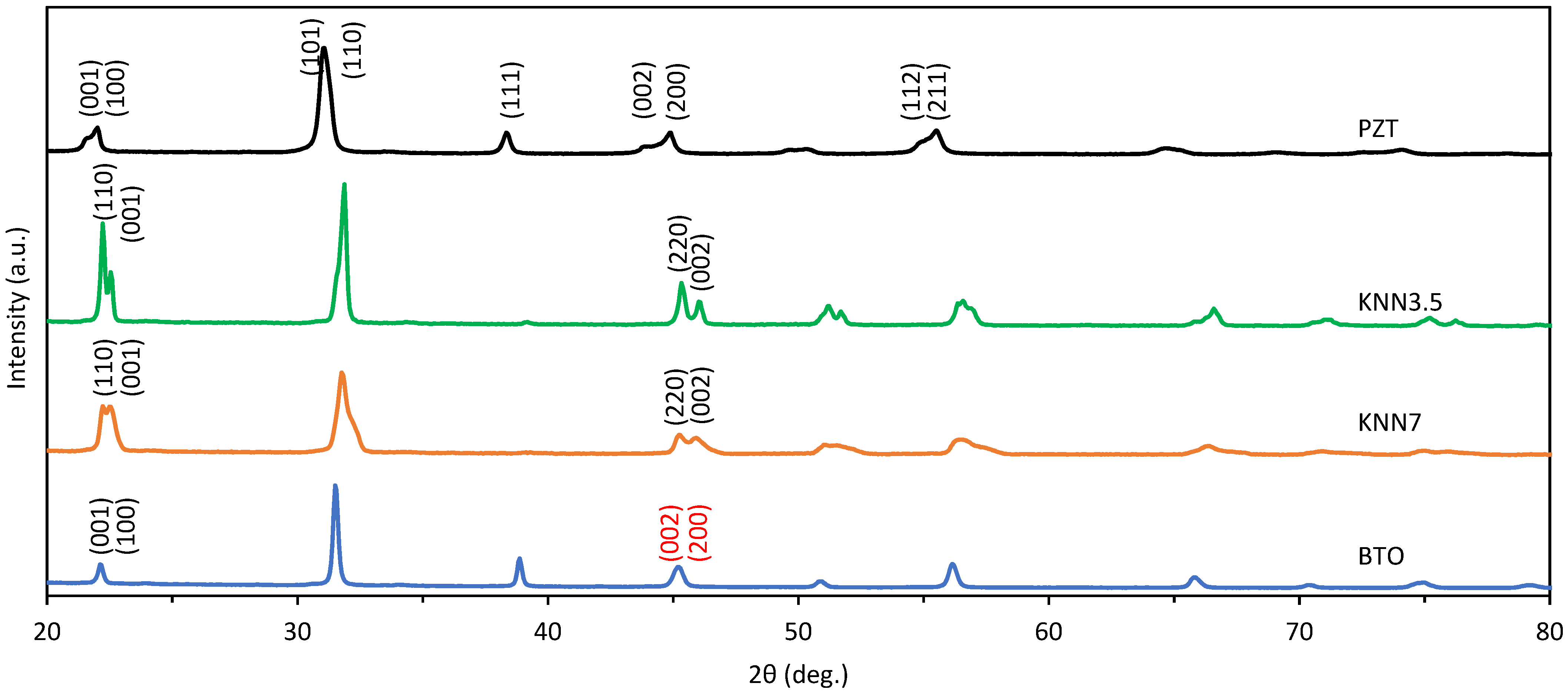
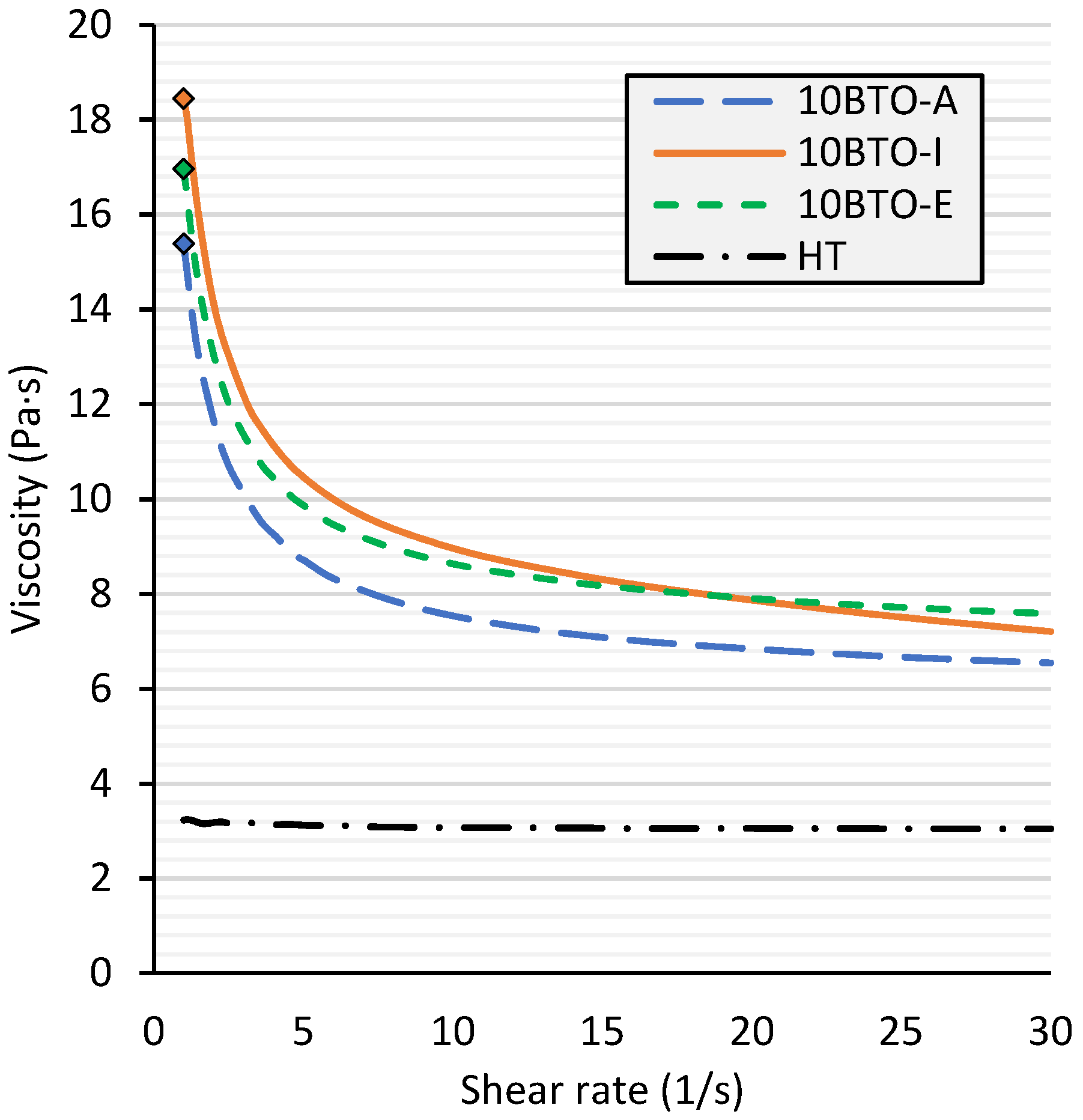

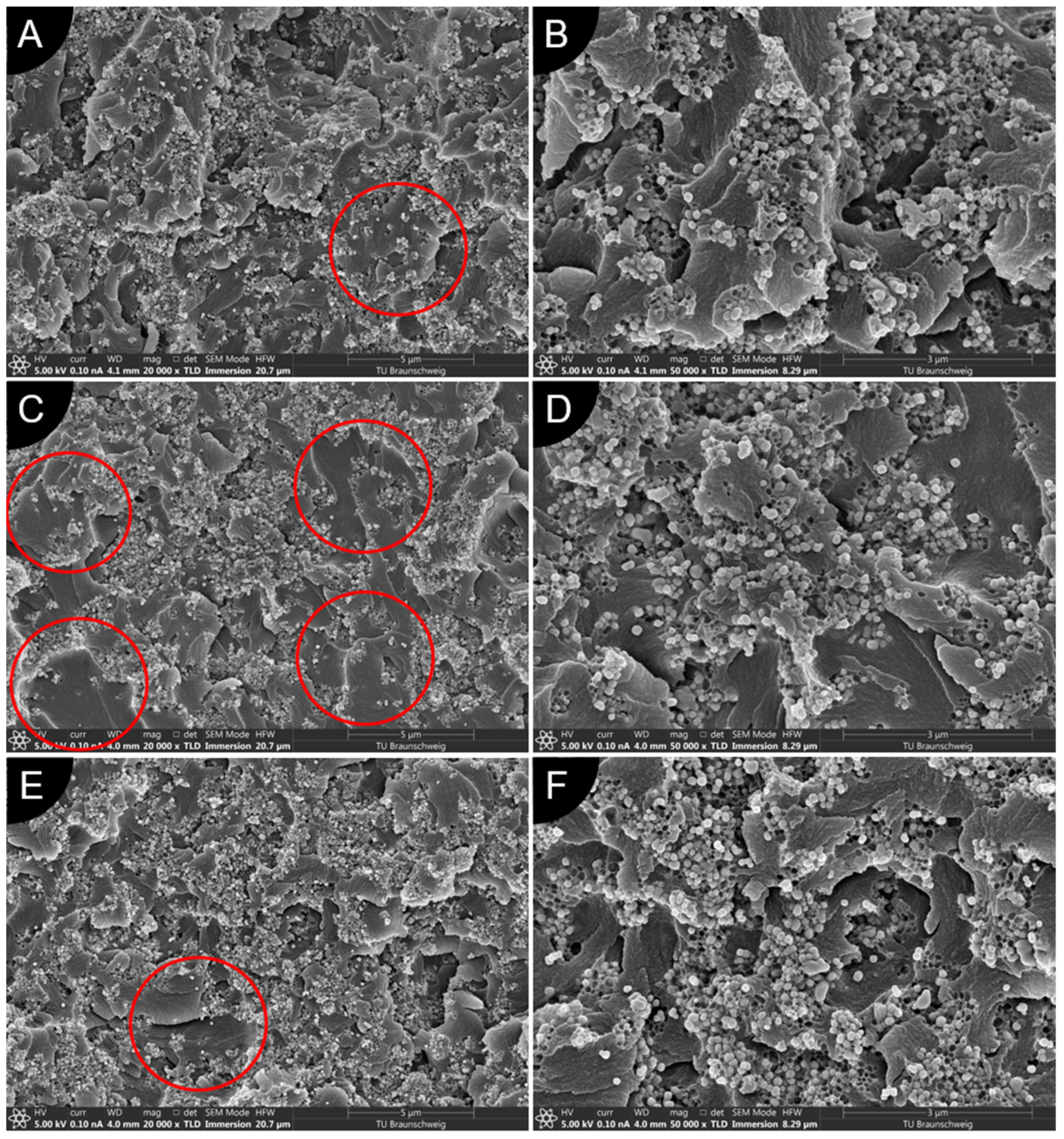
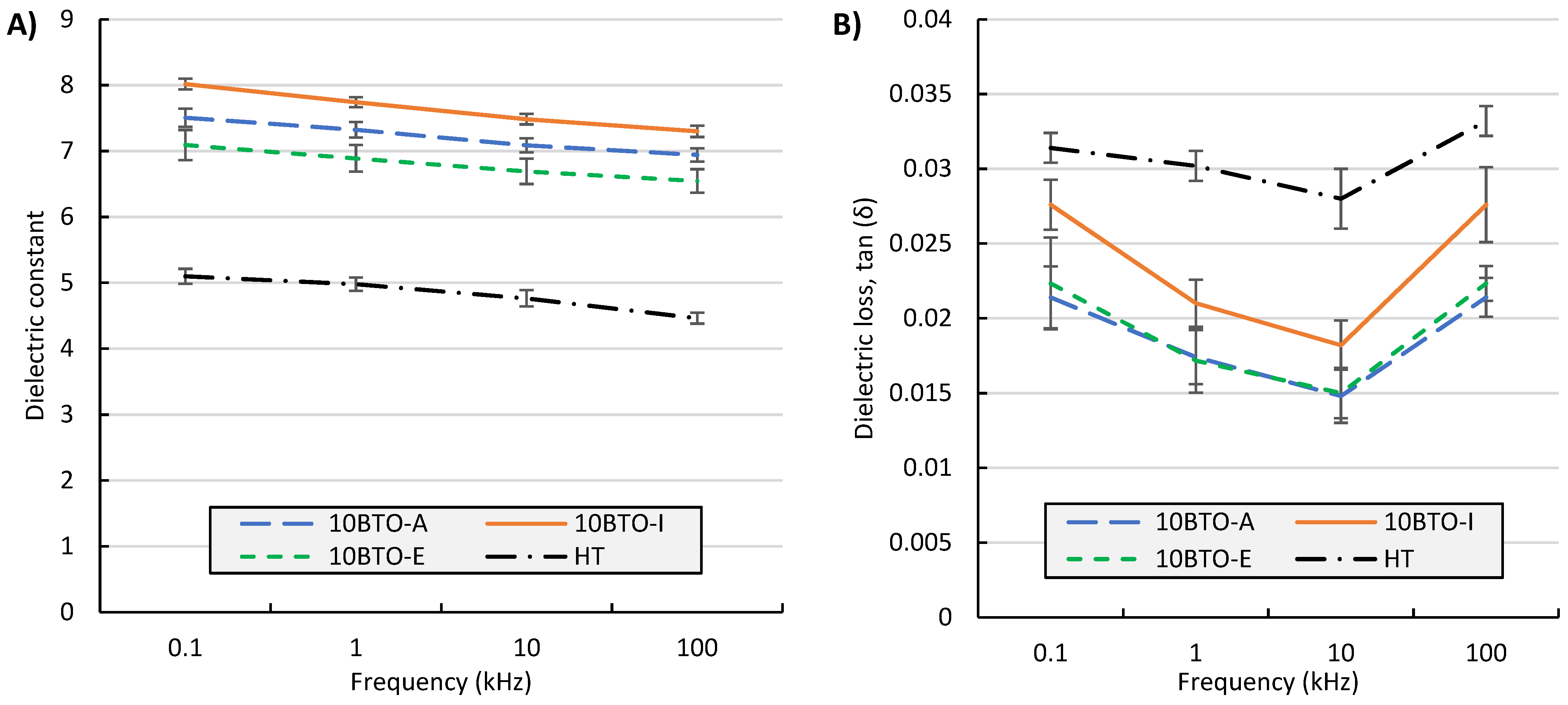

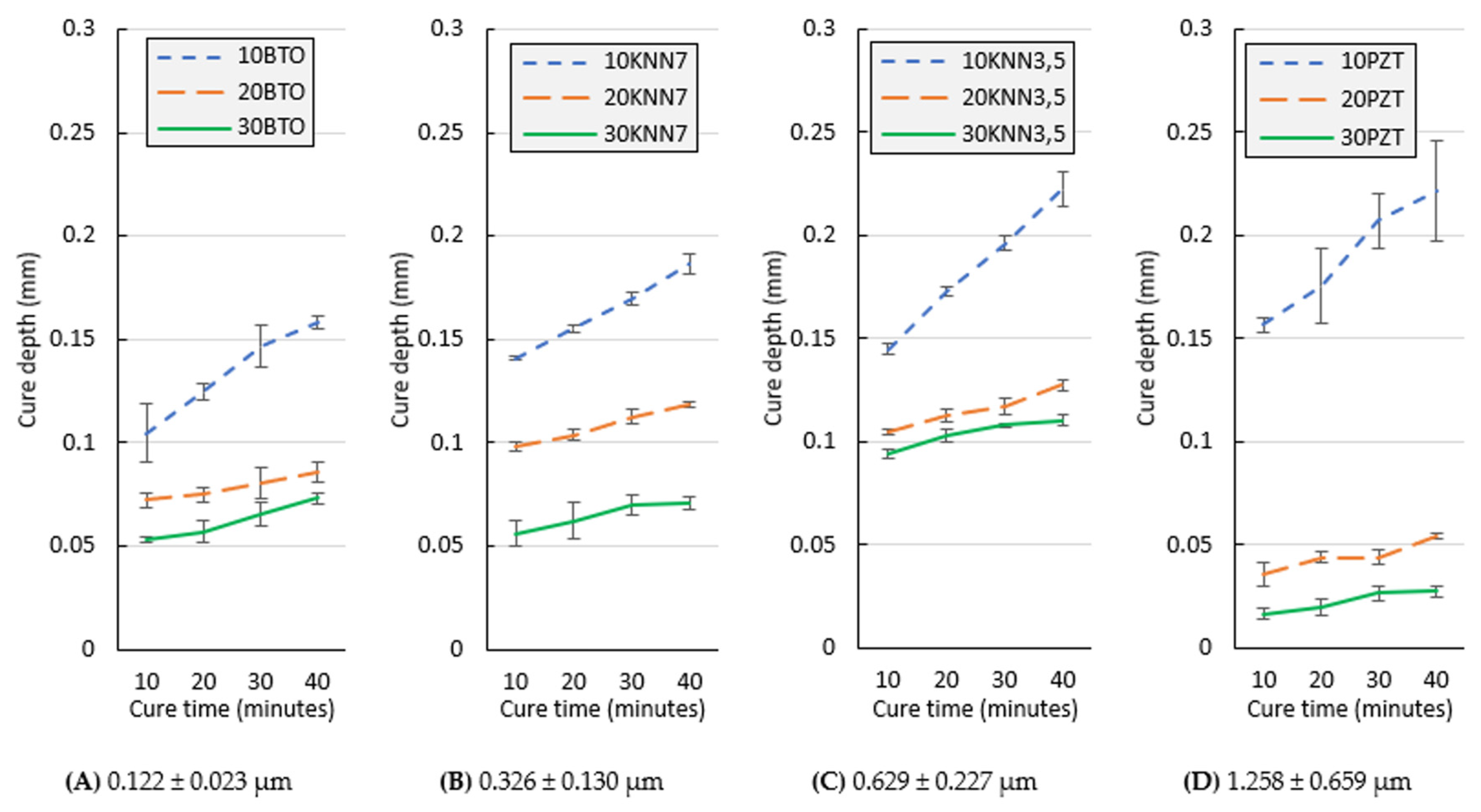

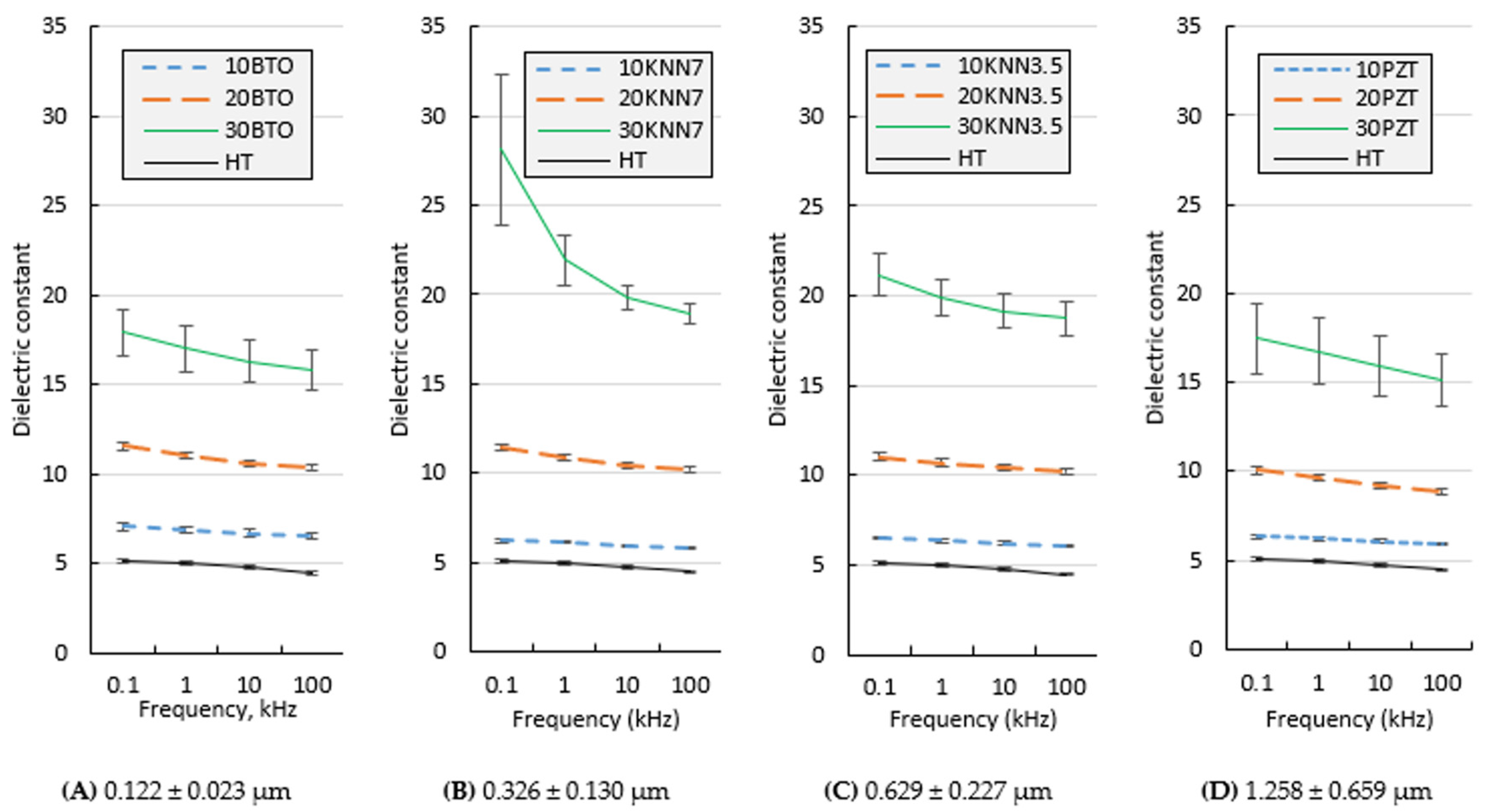
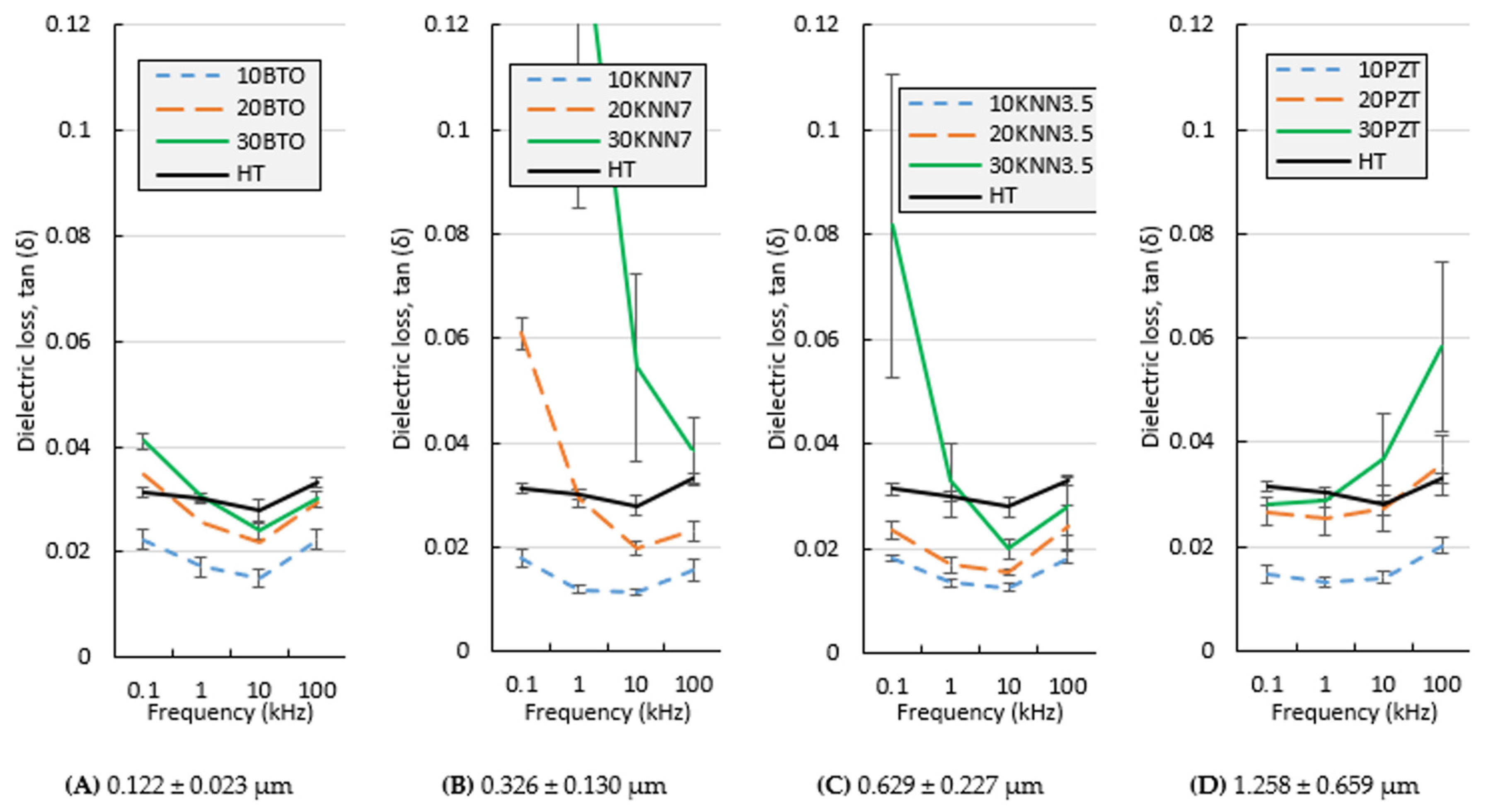
Publisher’s Note: MDPI stays neutral with regard to jurisdictional claims in published maps and institutional affiliations. |
© 2022 by the authors. Licensee MDPI, Basel, Switzerland. This article is an open access article distributed under the terms and conditions of the Creative Commons Attribution (CC BY) license (https://creativecommons.org/licenses/by/4.0/).
Share and Cite
Mitkus, R.; Sinapius, M. Piezoelectric Ceramic/Photopolymer Composites Curable with UV Light: Viscosity, Curing Depth, and Dielectric Properties. J. Compos. Sci. 2022, 6, 212. https://doi.org/10.3390/jcs6070212
Mitkus R, Sinapius M. Piezoelectric Ceramic/Photopolymer Composites Curable with UV Light: Viscosity, Curing Depth, and Dielectric Properties. Journal of Composites Science. 2022; 6(7):212. https://doi.org/10.3390/jcs6070212
Chicago/Turabian StyleMitkus, Rytis, and Michael Sinapius. 2022. "Piezoelectric Ceramic/Photopolymer Composites Curable with UV Light: Viscosity, Curing Depth, and Dielectric Properties" Journal of Composites Science 6, no. 7: 212. https://doi.org/10.3390/jcs6070212
APA StyleMitkus, R., & Sinapius, M. (2022). Piezoelectric Ceramic/Photopolymer Composites Curable with UV Light: Viscosity, Curing Depth, and Dielectric Properties. Journal of Composites Science, 6(7), 212. https://doi.org/10.3390/jcs6070212







